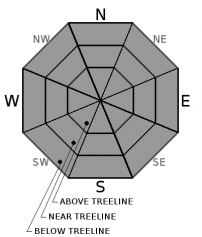| Saturday | Saturday Night | Sunday | |
|---|---|---|---|
| Weather: | Partly cloudy with increasing clouds and a slight chance of rain showers this afternoon and evening in the northern part of the forecast area | Mostly cloudy | Mostly cloudy with a slight chance of rain showers in the afternoon |
| Temperatures: | 49 to 55 deg. F. | 31 to 36 deg. F. | 47 to 53 deg. F. |
| Mid Slope Winds: | Southwest | Southwest | South |
| Wind Speed: | 20 to 30 mph with gusts to 50 mph | 15 to 25 mph with gusts to 40 mph | 15 to 25 mph with gusts to 40 mph |
| Expected snowfall: | 0 | 0 | 0 |
| Saturday | Saturday Night | Sunday | |
|---|---|---|---|
| Weather: | Partly cloudy with increasing clouds and a slight chance of rain or snow showers this afternoon and evening in the northern part of the forecast area. Snow levels between 8000 and 9000 ft. | Mostly cloudy | Mostly cloudy with a slight chance of rain or snow showers in the afternoon. Snow levels between 8000 and 8500 ft. |
| Temperatures: | 44 to 52 deg. F. | 29 to 34 deg. F. | 42 to 50 deg. F. |
| Ridge Top Winds: | Southwest | Southwest | South |
| Wind Speed: | 30 to 50 mph with gusts to 100 mph decreasing to 90 mph in the afternoon | 30 to 45 mph with gusts to 90 mph | 25 to 40 mph with gusts to 80 mph decreasing to 70 mph in the afternoon |
| Expected snowfall: | 0 | 0 | 0 |























